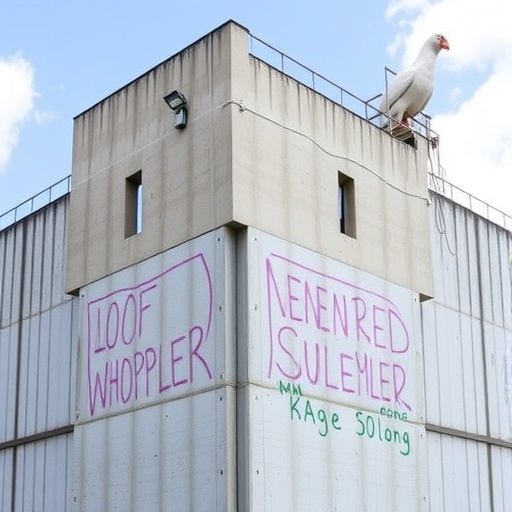Recent advancements in sustainable construction materials have led to increased interest in utilizing agricultural by-products as viable components in concrete production. Among these innovations, sugarcane bagasse ash (SCBA) has emerged as a significant material that can enhance the mechanical properties of concrete. A recent study by researchers Pandey and Kishor critically evaluates the mechanical performance of concrete incorporating SCBA and recycled fine aggregate (RFA). This innovative blend not only addresses environmental concerns but also enhances the compressive strength of concrete, making it suitable for sustainable pavement applications.
In the quest for sustainable building materials, the construction industry faces the dual challenge of reducing waste while improving material efficacy. Concrete, one of the most widely used construction materials globally, has typically relied on non-renewable resources which contribute to ecological degradation. The introduction of SCBA, a waste product from sugar manufacturing, is a breakthrough in creating eco-friendly concrete mixtures. SCBA is known for its pozzolanic properties, which can potentially transform the concrete’s structural integrity when combined with traditional aggregates.
The researchers conducted a series of experiments to evaluate how varying proportions of SCBA and recycled fine aggregate influence the compressive strength of concrete. Their findings reveal that concrete mixes containing SCBA resulted in enhanced strength characteristics. It’s worth noting that the optimal replacement percentages of Portland cement with SCBA yield significant benefits. This emphasizes the need for thorough experimentation to optimize the ratios for achieving maximum compressive strength, which is crucial for pavement applications.
In addition to mechanical improvements, the environmental impact of using recycled fine aggregate cannot be understated. The construction sector generates considerable waste, and RFA provides a sustainable alternative to natural sand. Utilizing RFA not only diminishes landfill burdens but also curbs the depletion of natural resources. Pandey and Kishor’s study highlights the synergetic interaction between SCBA and RFA, where the inclusion of both can lead to more sustainable and durable concrete formulations.
Furthermore, the researchers’ analysis included durability tests to assess the long-term performance of concrete made with SCBA and RFA. Durability is a key factor for pavement materials, which must withstand weathering, chemical attacks, and wear over time. The study shows promising results, indicating that pavements constructed with such sustainable concrete mixtures possess superior durability compared to traditional concrete compositions.
Understanding the economic aspects of implementing these materials into mainstream construction processes is equally important. The use of SCBA and RFA can result in reduced material costs, considering that both are often cheaper alternatives to conventional cement and aggregates. Thus, by reducing dependency on expensive, traditional materials, the construction industry can increase its profitability while promoting sustainable practices. This could catalyze a larger-scale adoption of eco-friendly building initiatives.
Additionally, the energy consumption associated with producing traditional concrete mixtures is substantial. The incorporation of SCBA significantly reduces the energy footprint, transforming concrete into a green building material. This reduction aligns with global initiatives aimed at cutting carbon emissions, placing the construction industry at the forefront of environmental responsibility. Adopting sustainable materials could lead to a ripple effect, inspiring further innovations within the sector.
Another crucial aspect of the study is the implications of using SCBA and RFA on the overall lifecycle assessment of pavements. By considering the complete lifecycle from material extraction to construction and beyond, the researchers argue for a holistic approach in evaluating pavement sustainability. Integrating SCBA can lead to less resource-intensive practices, resulting in lower environmental burdens associated with concrete production.
As technological advancements in material science continue to evolve, partnerships between researchers and the construction industry will become increasingly important. Collaborative efforts can help facilitate knowledge transfer regarding sustainable practices, ensuring that innovative materials like SCBA and RFA reach their full potential in real-world applications. As more construction companies pilot these materials, we can expect to see an increase in the acceptance of sustainable concrete solutions.
Moreover, the findings of this study invite future research to explore the integration of additional agricultural by-products that could further improve the sustainability of concrete. Future investigations into the optimal combinations will not only refine the material properties but will also pave the way for developing new, sustainable construction methodologies. Such approaches could significantly alter the landscape of how we build in an environmentally-conscious manner.
In conclusion, the innovative use of sugarcane bagasse ash and recycled fine aggregate offers a promising pathway toward sustainable construction. The research conducted by Pandey and Kishor emphasizes the mechanical robustness and eco-friendliness of these materials, making them potential staples in future pavement applications. As the world seeks solutions to environmental challenges, studies like these represent critical steps forward in creating a more sustainable infrastructure.
The utilization of natural waste materials in construction can redefine how society views resource consumption and waste management. The construction sector’s adoption of SCBA and RFA might not only lead to significant cost savings and enhanced material properties but also foster a greater commitment to sustainability in all facets of construction practices.
By embracing innovative materials and sustainable practices, the industry can move toward a future where constructing durable, sustainable, and environmentally-responsible structures is the norm rather than the exception.
Subject of Research: The evaluation of mechanical properties and optimization of compressive strength of concrete incorporating sugarcane bagasse ash and recycled fine aggregate for sustainable pavement applications.
Article Title: Evaluation of mechanical properties and optimization of compressive strength of concrete incorporating sugarcane bagasse ash and recycled fine aggregate for sustainable pavement applications.
Article References:
Pandey, S., Kishor, R. Evaluation of mechanical properties and optimization of compressive strength of concrete incorporating sugarcane bagasse ash and recycled fine aggregate for sustainable pavement applications.
Environ Sci Pollut Res (2025). https://doi.org/10.1007/s11356-025-37212-7
Image Credits: AI Generated
DOI: https://doi.org/10.1007/s11356-025-37212-7
Keywords: Sustainable concrete, sugarcane bagasse ash, recycled fine aggregate, compressive strength, mechanical properties, pavement applications.




